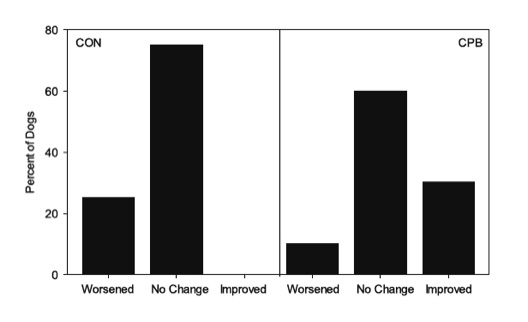
animal health consulting
CardioCare by Purina
what does the science really say?
Christine King BVSc, MANZCVS (equine), MVetClinStud
Full disclosure: I have written a book on feeding dogs, Feeding Miss Lilly (revised edition). I'm a fan of feeding wholesome, species-appropriate diets, which for dogs includes meat-based and low/no starch. That's where I'm coming from when I sat down to examine this study.
***
Here is the claim Purina makes about CardioCare on its website directed at vets:
"Purina Pro Plan Veterinary Diets CC CardioCare represents a breakthrough in the role nutrition offers for dogs with early stage mitral valve disease. The novel scientific approach has led to the development of a transformational diet that slows progression of the condition in dogs." — Dr. Jason Gagne, DVM, DACVIM (Nutrition)
But does it? If so, how well does it measure up to this claim?
The claim ("slows progression of the condition in dogs") is based on a study by Purina in which 10 dogs with early mitral valve disease were fed a prototype of CardioCare for 6 months. They called this diet 'cardiac protection blend', or CPB.
At the same time, another 8 dogs (initially 9 dogs) with early mitral valve disease were fed a standard Purina ration (what Purina describes as "complete and balanced nutrition for adult dogs"). They called this diet Control, or CON.
That's not a lot of dogs on which to base such a sweeping claim. (And all but two of the dogs were Beagles; the others were Miniature Schnauzers. More on the dogs and the diets later.)
So, what happened after 6 months on their respective diets?
Mitral regurgitation (valve leakage)
Severity of mitral valve leakage, or 'regurgitation', was one of the three 'primary outcomes', a statistical term for the findings of primary interest. (The other two were measurements of the left atrium, which I'll discuss on the next two pages. The primary pathology of 'myxomatous mitral valve disease' in dogs is degeneration of the mitral valve. Enlargement of the left atrium occurs as a result of mitral valve incompetence.)
Severity was graded as none/trace, mild, moderate, or severe, using colour-flow Doppler echocardiography ("echo"). All 19 dogs* had mitral regurg at the start; 2 mild, 10 moderate, and 7 severe.
*One dog was removed after 3 months, so only 18 dogs completed the 6-month study period.
CON diet
In the 8 dogs fed the Control diet, mitral regurgitation was unchanged in 6 dogs and worse in 2 dogs.
The number of dogs in this study is too small for percentages to reliably predict performance in all dogs with, or at risk of developing, mitral valve disease. But for simplicity's sake, 75% of the dogs fed this standard Purina diet had no change in the degree of mitral regurgitation after 6 months, and the other 25% showed the deterioration in mitral valve competency that is characteristic of this slowly degenerative disease.
CPB diet
In the 10 dogs fed the CardioCare prototype, mitral regurgitation was unchanged in 6 dogs, improved in 3 dogs, and worse in 1 dog.
Again, percentages are unreliable in such a small group of dogs, but let's do it anyway: 60% of the dogs fed this CardioCare prototype had no change in the degree of mitral regurgitation after 6 months; 30% showed improvement, and 10% showed deterioration.
Comparing the two diets
No statistical analysis was done comparing changes in mitral regurgitation (MR) over time between the two diets. Why is not explained. Or if they did do it, they have not shared that with us.
In comparison, they did statistical analysis on body condition score, which is another variable (statistical term) that is categorised rather than measured ('categorical', or assigned to a particular box, rather than 'continuous' like age or body weight).
Actually, body condition score and mitral regurg severity are 'ordinal' variables. Individual values are assigned to a particular numbered box. The boxes are arranged or ordered in a way that reflects the magnitude of the particular thing being described, such as body fat deposits or amount of mitral regurg. In contrast, gender is a purely categorical variable. But that's just some hair-splitting for us nerdy types. The point is that they didn't do analysis on something they could have — and something that was a top-priority variable!
So, I did some simple stats on their data... Because we're most interested in population-level relevance here (i.e., what this study is likely to mean for your dog), I assigned each dog a MR severity score, from 1 (for mild) to 3 (for severe), at each of the three time points (baseline, 3 months, and 6 months). I then added up (summed) all of the MR scores for each diet group at each time point and calculated the average (total ÷ number of dogs) for that diet on that day. In this way, I was attempting to get a handle on the magnitude of the MR burden for each group on each day.
At baseline, the sum-average MR score for the dogs in the CON group was substantially lower than that of the dogs in the CPB group. Whereas it was 6 in the CON group, it was 8.3 in the CPB group — i.e., there were more dogs with severe MR in the CPB group at the start. (You'll see that illustrated in the coloured graph further down the page.)
After 6 months, the sum-average MR score was still 6 for the dogs in the CON group and it dropped by only 1 point, to 7.3, in the CPB group. It's a drop, but it's not a very impressive drop.
By the way, in both groups there was a small uptick at 3 months that disappeared by 6 months. (Sum-average MR score at 3 months was 6.3 in the CON group and 8.7 in the CPB group.) I discuss this phenomenon on page 3...
Now let's look at their data another way. Of the 18 dogs with early mitral valve disease who completed the 6-month study period, mitral regurgitation was unchanged in 12 dogs (67%), improved in 3 dogs (17%), and worse in 3 dogs (17%). (Yes, I know; that adds up to 101%... I rounded up to the nearest whole number for ease of reading.)
In other words, there was no change in two-thirds of the dogs, as one might expect for a slowly degenerative disease, re-evaluated after only 6 months, in dogs still in the early or preclinical stages, and fed a junkfood diet (the first three ingredients in CardioCare are "oat meal, corn gluten meal, rice").
The main difference between the two diets was that the only dogs who showed improvement in mitral regurg were fed the CPB diet.
That's not nothing; in fact, it's quite remarkable. It makes me want to take a closer look at the individual components that made the CPB diet different from the CON diet, and add them to a healthy, species-appropriate canine diet in dogs at high risk for mitral valve disease (e.g., Cavalier King Charles Spaniels) and in dogs who already have mitral valve disease. (More on the specifics later.)
However, this result is necessarily dampened by the fact that the majority of the dogs fed the CPB diet showed no change, and one dog was worse despite this "transformational" diet.
So, it's a stretch to claim that CardioCare "slows progression of the condition in dogs." Some dogs, yes; but by no means all, nor even most dogs.
Here is how they presented these data in their paper:
Not so impressive, is it? Ah, the power of a simple bar graph! Oversimplifying something can end up misleading (more on this issue later).
Incidentally, murmur grade on auscultation (by stethoscope) was unchanged in all dogs with mitral valve disease, regardless of diet (CON or CPB).
***
I have much more to say about this study and the ... shall we say, creative way they used statistical methods and graphs to show (and exaggerate) statistically significant changes in left atrial diameter that are unlikely to be clinically significant (i.e., relevant in the real world).
The upshot is that the CardioCare prototype had very little effect on left atrial dimensions after 6 months. At best, it slowed progression of left atrial enlargement in some dogs — but not in others, as one might expect when there has been no change in the severity of mitral regurgitation.
***
In case you don't have time to read on, here is the list of ingredients that were included in the CPB diet but not added to the CON diet:
* MCT oil, 5%
* fish oil, 2.9%
* fish meal, 3.4% [akin to "chicken meal"... parts not fit for humans]
* L-lysine, 1.3% [lysine is an essential amino acid]
* DL-methionine, 1% [methionine is an essential amino acid]
* taurine, 0.13% [taurine is an amino acid that, while not essential, may be beneficial]
* magnesium sulphate, 0.2%
* DL-alpha tocopherol, 0.15% [synthetic vitamin E]
© Christine M. King, 2022. All rights reserved.
First published 19 September, 2022. Last updated 23 September, 2022.

Impressive, no? But here's what the data look like, plotted more realistically, dog by dog:
